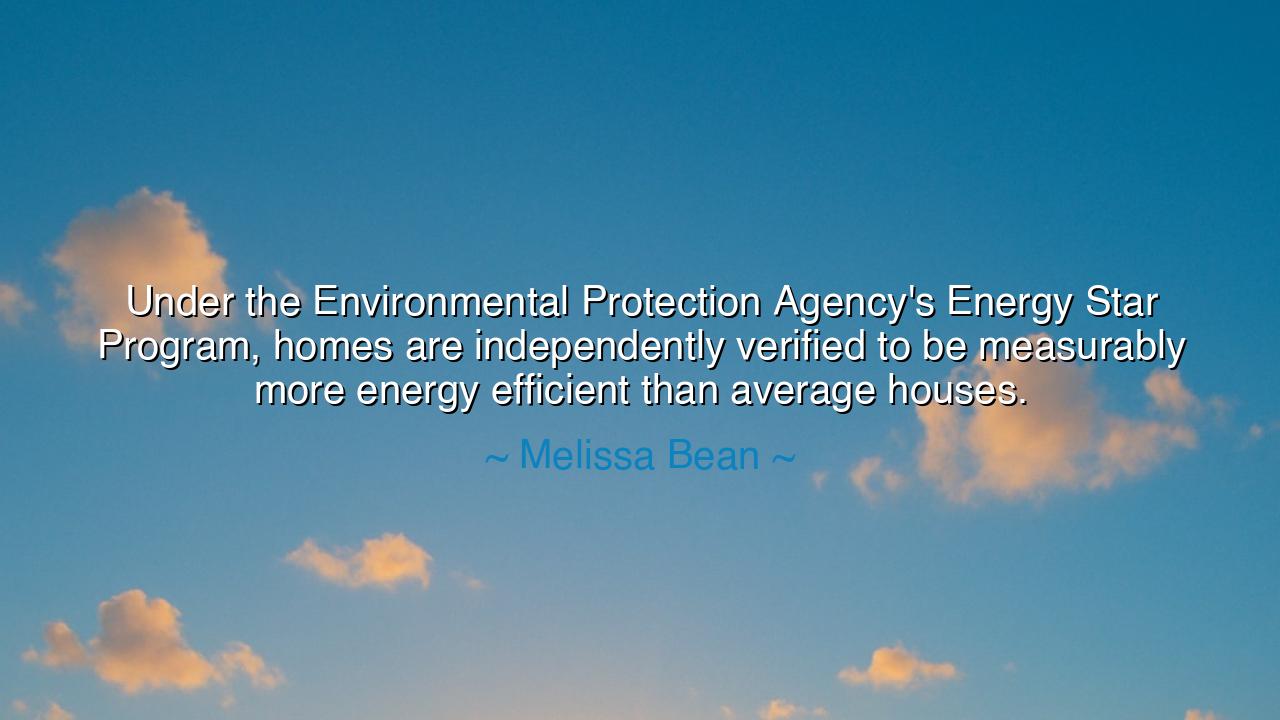
Under the Environmental Protection Agency's Energy Star Program
Under the Environmental Protection Agency's Energy Star Program, homes are independently verified to be measurably more energy efficient than average houses.






In the councils of elders, it was said that a wise household wastes neither fire nor breath. Thus Melissa Bean’s plain-spoken vow—“Under the Environmental Protection Agency’s Energy Star Program, homes are independently verified to be measurably more energy efficient than average houses.”—rings like a steward’s bell. Beneath its modern cadence lies an ancient ethic: bind comfort to conscience, yoke shelter to stewardship, and let proof—not boast—declare a dwelling’s virtue. She reminds us that a good house is not only beautiful in sunlight; it is honest in its numbers.
Mark the key words she sets like stones across a ford. Independently verified: the promise that another pair of eyes will test the walls we build, that the wind and the bills will not expose our carelessness later. Measurably: the humility to count what matters—heat lost, air leaked, watts consumed—so that praise rests on evidence, not on paint. Energy efficient: the craft of getting more winter from less fuel, more summer from less hum, more light from fewer watts. Such phrases are the grammar of a civilization that would pass on blessings without passing on burdens.
Consider a living parable. A young family builds on a modest lot at the town’s edge. Their builder follows the Energy Star Program path: thicker insulation laid without gaps, seams taped like a sailor’s best sail, ducts sealed and pressure-tested, windows set true, an electric heat pump humming with quiet thrift. A rater arrives with instruments—blower door, manometer, infrared eye—and the house submits to trial. Numbers rise and fall; leaks are hunted and mended; the certificate is earned. Come winter, the children sleep warm while the utility meter turns like a clock in prayer—slow and steady. The savings buy books and trees; the comfort buys peace.
The ancients would cheer the honesty of such rites. For they knew that intention without testing breeds self-deception. A temple’s stones are sounded with a hammer; a boat is launched in rough water; a bridge is walked before wagons cross. So a home that would be a refuge must first be tried by air and flame. This is not suspicion; it is love made careful. And when the dwelling keeps its promise, it honors more than the owner—it honors the river not warmed needlessly, the air not fouled, the grid not strained to the edge of night.
Nor is this only a private virtue. Neighborhoods of quiet, thrifty houses become towns with calmer winters and kinder summers: fewer shutoff notices, fewer fevers from poor ventilation, fewer choices between heat and food. Roof by roof, a people’s resilience thickens. Here the “program” becomes a covenant—voluntary, yes, but communal in its effect. We learn again that small obediences, repeated, make a city breathe.
From Bean’s sentence, take a clear lesson: seek truth you can meter. Let your pride be in measurably lower bills, in air that stays where you paid to warm it, in light that glows without groaning wires. Prefer a standard with a stranger’s signature to a slogan with your own. The star on the label is not decoration; it is the echo of tests you did not have to watch, done so you do not have to worry.
Let counsel become practice. If you build, ask for the blower-door test and the duct test as you would ask a doctor for vitals; demand continuous insulation and careful air-sealing; pair tightness with fresh-air ventilation so lungs and walls both thrive. If you buy, read the rating as you would read a deed. If you simply dwell, still you can join the liturgy of thrift—seal the cracks, tune the system, replace old bulbs with new stars, let curtains work with the sun, and plant shade that will outlive you. Do these things quietly, faithfully, and your home will join the ancient fellowship of shelters that keep their people and their promises at once—warm in winter, cool in summer, gentle on the earth, and proven so.






AAdministratorAdministrator
Welcome, honored guests. Please leave a comment, we will respond soon